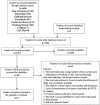Impacts of Internet-Based Interventions for Veterans With PTSD: A Systematic Review and Meta-Analysis
- PMID: 34899460
- PMCID: PMC8652137
- DOI: 10.3389/fpsyg.2021.711652
Impacts of Internet-Based Interventions for Veterans With PTSD: A Systematic Review and Meta-Analysis
Abstract
Background: Veterans who did not seek and complete treatment as intended have been shown to have an elevated risk of experiencing and being exposed to post-traumatic stress disorder (PTSD). Internet-based interventions (IBIs) provide more confidentiality and fewer treatment barriers, and they are regarded as potential treatments to reduce PTSD in veterans. However, the effects of IBI for veterans with PTSD are inconclusive. Objectives: IBI is defined as any internet-based series of psychosocial interventions, of which the internet works as a way of delivery. Psychosocial content and reduction of PTSD symptoms in veterans have been recognized as two core elements of this intervention. This study aimed to (1) examine the effects of IBI on veterans' PTSD outcomes and (2) distinguish between the elements of IBI that play an important role for veterans with PTSD. Methods: Web of Science, PubMed, EMBASE, PsycINFO, Cochrane, Wanfang Data, CNKI, and CQVIP databases were searched for randomized controlled trials (RCT) in IBI programs for veterans with PTSD, covering all studies in English and Chinese published from January 1990 to November 2020. Also, related studies tracking citations were identified. Studies met the following inclusion criteria of (1) being RCTs; (2) containing IBI in the full text; (3) having IBI conducted on veterans as participants; and (4) being on PTSD. All processes followed PRISMA. The risk of bias of the studies was assessed by the Cochrane Systematic Review Handbook. The confidence of outcomes of this review was valued according to the GRADE (Grading of Recommendations Assessment, Development, and Evaluation). The meta-analysis was done by RevMan 5.13. Two teams of reviewers independently searched the literature, made the assessment, and extracted the data. Results: A total of 1,493 citations were identified after initial searching, of which the full texts of 66 studies were screened. Eventually, six RCT studies met the inclusion criteria. Beneficial effects of IBI were found on the overall PTSD outcome (-0.29; 95% CI-0.48 to -0.11, p<0.01). Particularly, IBI based on cognitive behavioral therapy (CBT) with peer support was found to be effective for PTSD outcomes (-0.36; 95% CI-0.61 to -0.11, p<0.01). The subgroup analysis demonstrated that scores of PTSD outcome measured by a PCL (PTSD Checklist) decreased to an average score of 0.38 (95% CI -0.60 to -0.15, p=0.001). The intervention had a positive effect on the PTSD outcome on veterans with comorbid psychological disorders (-0.30; 95% CI -0.61 to -0.11, p<0.01). Overall, the six studies included were evaluated with a low risk of bias, and the outcomes of the meta-analysis were proven with high confidence. Conclusion: On the whole, IBIs have a positive effect on the overall PTSD outcome of veterans. The results encouraged us to focus on IBI with CBT with peer support for veterans, on specific instruments for veterans with PTSD, and on veterans with comorbid psychological disorders. This study, however, has limits. Only six studies with a Western population were included, which might result in cultural bias on IBI effects. In future, more high-qualified research and diverse cultural background of RCTs is needed to prove the effectiveness of IBI on veterans with PTSD.
Keywords: PTSD; internet-based intervention; meta-analysis; randomized controlled trials; veterans.
Copyright © 2021 Zhou, Bai, Wu, Fan, Wu, Li and Li.
Conflict of interest statement
The authors declare that the research was conducted in the absence of any commercial or financial relationships that could be construed as a potential conflict of interest.
Figures









Similar articles
-
Interventions for adults with a history of complex traumatic events: the INCiTE mixed-methods systematic review.Health Technol Assess. 2020 Sep;24(43):1-312. doi: 10.3310/hta24430. Health Technol Assess. 2020. PMID: 32924926 Free PMC article.
-
Beyond the black stump: rapid reviews of health research issues affecting regional, rural and remote Australia.Med J Aust. 2020 Dec;213 Suppl 11:S3-S32.e1. doi: 10.5694/mja2.50881. Med J Aust. 2020. PMID: 33314144
-
The future of Cochrane Neonatal.Early Hum Dev. 2020 Nov;150:105191. doi: 10.1016/j.earlhumdev.2020.105191. Epub 2020 Sep 12. Early Hum Dev. 2020. PMID: 33036834
-
Combat and Operational Stress Control Interventions and PTSD: A Systematic Review and Meta-Analysis.Mil Med. 2022 Jul 1;187(7-8):e846-e855. doi: 10.1093/milmed/usab310. Mil Med. 2022. PMID: 34318331
-
Psychological therapies for the treatment of post-traumatic stress disorder in children and adolescents (Review).Evid Based Child Health. 2013 May;8(3):1004-116. doi: 10.1002/ebch.1916. Evid Based Child Health. 2013. PMID: 23877914 Review.
Cited by
-
Assessing the effectiveness of internet-based interventions for mental health outcomes: an umbrella review.Gen Psychiatr. 2024 Jul 18;37(4):e101355. doi: 10.1136/gpsych-2023-101355. eCollection 2024. Gen Psychiatr. 2024. PMID: 39040128 Free PMC article. Review.
-
Prevalence and Distribution of Mental Disorders at Inpatient Psychiatry Service of a Large Military Hospital in Ukraine.Psychiatry Clin Psychopharmacol. 2025 Aug 11;35(Suppl 1):S47-S56. doi: 10.5152/pcp.2025.24871. Psychiatry Clin Psychopharmacol. 2025. PMID: 40864899 Free PMC article.
-
A meta-analysis of internet-based cognitive behavioral therapy for military and veteran populations.BMC Psychiatry. 2023 Apr 3;23(1):223. doi: 10.1186/s12888-023-04668-1. BMC Psychiatry. 2023. PMID: 37013501 Free PMC article. Review.
References
Publication types
LinkOut - more resources
Full Text Sources
Miscellaneous

